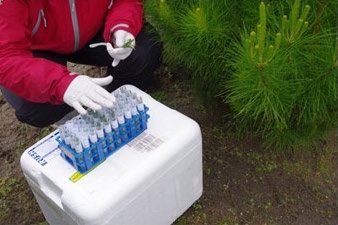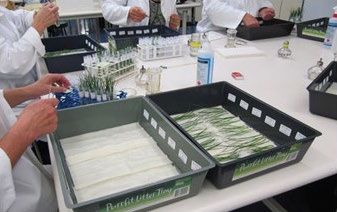PESTS AND DISEASES OF FORESTRY IN NEW ZEALAND
Screening for resistance to Phytophthora
Scion is the leading provider of forest-related knowledge in New Zealand
Formerly known as the Forest Research Institute, Scion has been a leader in research relating to forest health for over 50 years. The Rotorua-based Crown Research Institute continues to provide science that will protect all forests from damage caused by insect pests, pathogens and weeds. The information presented below arises from these research activities.
From Forest Health News 253, January/February 2015.
Phytophthora is a genus of soil or airborne plant pathogens that infect a vast range of plant species worldwide. In New Zealand, three examples are red needle cast on radiata pine (caused by Phytophthora pluvialis), kauri dieback (caused by Phytophthora taxon Agathis) and crown rot in apples (caused by Phytophthora cactorum). Scion’s Healthy trees healthy future programme is aiming to identify and improve our understanding of the mechanisms underlying resistance to Phytophthora infection in each of those host species.

A first step to identify resistance mechanisms to Phytophthora in radiata pine, is to recognize trees that perform well when exposed to the pathogen. Last year, the pathology team have been screening material in the nursery for resistance to P. pluvialis. The first group of plants to be tested has consisted of the Radiata Pine Breeding Company’s (RPBC) Elites, a structured population comprising 63 full-sib families from crosses between 55 unique parents. These industry-relevant families have been planted in trials across 6-7 sites in New Zealand, including some Dothistroma needle blight prone sites. These trials are also part of the RPBC and Scion’s Genomic Selection Partnership programme, thus providing a valuable opportunity to draw together all the genetic, health and wood quality information for these families.
To date, we have screened at least 6 individuals from each family using the detached needle assay method. This involved taking fascicles from plants to the laboratory, where they were inoculated then incubated for two weeks to allow lesions to develop. A team then carefully measured all the needles and recorded how many lesions were present and what their length was. This was an intensive task, with a single experiment capturing information from nearly 15 000 needles.

Over the last year we have screened over 400 different genotypes, which translates to nearly a quarter of a million needles measured. We have seen noticeable differences in the way trees respond to infection, with some trees developing severe lesions, while other trees remained largely unaffected with only occasional small lesions developing. The lesion measurements collected allowed us to make comparisons and identify which trees are more resistant or susceptible to red needle cast. Early results indicate that some of these differences are genetically controlled, which gives the RPBC an opportunity to breed for resistance and preferentially deploy this material on disease-prone sites.
Now that we have identified resistant and susceptible genotypes, we hope to start understanding what makes these trees respond differently. These trees are now being analysed using other techniques being developed in the HTHF programme, and clonal propagation is underway to generate sufficient material for screening. In addition, inoculations of radiata pines with P. kernoviae and P. cactorum are planned to determine if resistance to one species of Phytophthora could translate to cross-resistance to multiple Phytophthora species.
For more information and to keep updated on the HTHF programme, including our work on kauri dieback and crown rot in apples, you can sign up for our quarterly newsletter at http://www.healthytrees.co.nz.
Nari Williams and Natalie Graham
This information is intended for general interest only. It is not intended to be a substitute for specific specialist advice on any matter and should not be relied on for that purpose. Scion will not be liable for any direct, indirect, incidental, special, consequential or exemplary damages, loss of profits, or any other intangible losses that result from using the information provided on this site.
(Scion is the trading name of the New Zealand Forest Research Institute Limited.)

 Farm Forestry New Zealand
Farm Forestry New Zealand

